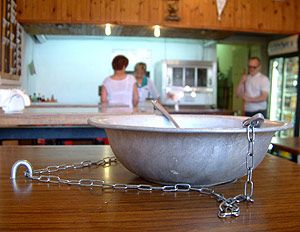don't pull their leg (legs?) boletus
You caught me in act with blood on my hands. :-)
Every milk bar is a little different, but here's the general procedure: Head to the counter, wait to be acknowledged, and point to what you want. Two handy words are "to" (sounds like "toe" and means "that") and "i" (pronounced "ee" and means "and").
My milk-bar dialogue usually goes like this: Milk Bar lady says "Prosze?" (Can I help you, please?). I say "to" (while pointing)... "i to" (pointing again) ... "i to" (pointing once more). It means, "That ... and that ... and that." It's not pretty, but it gets the job done.
articles.cnn/2007-11-16/travel/poland_1_milk-bar-poland-krakow?_s=PM:TRAVEL
it's from Jamie Stokes's column
I know Jamie Stocks's articles, and I like them too. Every one of them comes out in both languages: English and Polish under the generic name "Okiem Angola". They are linked to Kraków Post. He is also active at polandian.com blog.
Chimney sweepersFake or drunk chimney sweepers, who sell calendars and intimidate people, give a bad rap to this old and noble profession. A yearly visit from your friendly chimney sweeper is a messy but necessary affair. With some soot left in your ashpans and some on the floor but with the cleansed chimney flues both sides part in high spirits: he - with a satisfaction of a job well done and well earned money in his pocket and you - with an extra calendar, good stove draft and no fear of chimney fire for the next 12 months or so.
Yes, the dreaded chimney fire. Over the course of a season creosote deposits can become several inches thick. Creosote is a black, oily substance that builds up inside chimney flues when wood or coal burns incompletely, producing soot and tarry smoke. Since creosote is highly combustible, a thick accumulation creates a fire hazard. If a hot fire is built in the stove or fireplace, and the air control left wide open, this may allow hot oxygen into the chimney where it comes in contact with the creosote which then ignites - causing a chimney fire.
During my seven years adventure in the woods of Muskoka cottage country I solely relied on efficient airtight fireplace, with two little blowers efficiently dispersing the heat over the entire house. My heating costs were minimal - 12 face cords of well seasoned firewood, typically sugar maple, used to cost me from $35 to $65 a cord - the former if I bought it early in April-May, stacked it myself outdoors and let it dry until it was ready to be stacked in the woodshed attached to the cottage.
Quality firewood is one of the keys to avoid chimney fires. Resinous pine wood, branches or pine cones are not recommended because of quicker buildup of creosote in your chimney. But as I remember from my childhood - this kind of material was almost solely used for cooking during summer days. No wonder that the yearly visit from the chimney sweeper was a must.
I was told that when a fire department is called to chimney fire they dump some devilishly smelling fluid down your chimney. The smell will persists over the weeks to come. Forget about the comfort at your fireplace and weep. Secondly, the fire department and your local administration will charge you for services and penalize for negligence.
 PolishForums LIVE / Archives [3]
PolishForums LIVE / Archives [3]

